|
lakshana (लक्षण, ลักษณะ)
1. Sanskrit-Thai. 'Mark, sign,
symbol, characteristic'. In physiognomy the term refers to the features
of the body that may be auspicious or inauspicious, but in general it
refers to the auspicious signs of a great man, especially the 32 major
marks described in Buddhist literature, from which the predestination of
the Buddha may be recognized at birth.


2. Sanskrit-Thai. 'Attribute,
sign, symbol'. In iconography the term refers to the attributes of a
deity.

Lakshmana (लक्ष्मण)
Sanskrit. 'Endowed with
auspicious marks (lakshanas)'. Name of the younger half-brother of Rama
in the Indian epic Ramayana who, loyal to Rama, shared his 14 year long
exile and assisted him in the battle against Ravana. He is allegedly the
incarnation of Ananta, the naga seat of Vishnu. He has a golden
complexion.

Lakshmi (लक्ष्मी)
Sanskrit. 'Mark, sign'. Goddess
of beauty and good fortune, who surfaced during the churning of the
Ocean of Milk seated on the waves on a lotus flower. She became Vishnu's
consort and was incarnated with him each time he incarnated as one of
his avatars on earth. For example, she was born with him as Sita, the
wife of Rama, and as Rukmini, the principal wife of Krishna. The lotus
is one of her attributes and her mount is the lion. Also known as Sri,
Sri Mariamman and Padma.

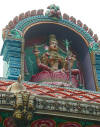
Lakulisha (लकुलिईश)
Sanskrit. 'Lord with a club'.
Reputed founder or first teacher of the Pashupati sect and by some
believed to be the 28th incarnation of the Hindu god Shiva as well as
the originator of yoga. In art usually depicted naked with a phallus
holding a club, prayer beads, a trident and a skull cup.

Lalitavistara (ललितविस्तर)
Sanskrit. 'Recitation of the
beloved one'. A Sanskrit text describing the traditional legend of the
Buddha's life.

Lamaism
A form of Buddhism mainly
practiced in Tibet and Mongolia.

Lanka
(लंका)
Sanskrit. Name used in the
Ramayana for Ceylon. It was once the summit of Mt. Meru but was blown
into the sea by Vayu, the god of wind, thus becoming an island. This
gigantic city kingdom of great majesty was encircled with seven broad
moats and seven strong walls. It was allegedly built of gold as a
residence for Kubera, from whom it was taken by his half-brother Ravana,
who made it his seat. Also Longka and Langka.

Lan
Nan Htu Su
Kayang name for a bird-like
angel.

Lan Tsai-ho (藍采和)
Chinese. Name of one of the
Eight Immortals. Although his age and sex are unknown Lan Tsai-ho is
usually portrayed as a effeminate boy carrying a bamboo basket which
contains a variety of flowers associated with longevity and which can be
used to communicate with the gods. His behaviour is out of norm and
known for its bizarreness, e.g. he walks around with one foot bare and
he likes to wear only shorts and thin shirts in winter whilst sleeping
on the snow, but in summer he wears a thick jacket and long pants. He
walks around singing and begging, though his songs, which were related
to immortality, were unintelligible to ordinary mortals. When he has
earned enough coins he strings them onto a necklace and then runs away
through the streets, not caring if the string would break and the coins
are lost, because when he has enough to eat he will distribute the rest
of his money to the poor. Lan Tsai-ho may also be depicted as a young
girl, a kathuy or an aged man. Sometimes transcribed Lan Caihe and Lan
Ts'ai-ho.


Lao
Tzu (老子)
Chinese. 'Old Master' or 'old
child', referring to his birth in which, according to legend, he emerged
as a full-grown man with white hair and a full grey beard. He was an
influential Chinese philosopher in the 4th century BC, founder of Taoism
and author of the Tao-te Ching. Little is known about the life of Lao
Tzu. In legend, it is said that he was conceived when his mother gazed
upon a falling star and he stayed in his mother's womb where he matured
for several decades (compare with Phra Siwalih). His mother eventually
gave birth to a full-grown man, whilst leaning against a plum tree.
Tradition says he was born in Ku Xian, a prefecture of the state of Chu,
today's Luyi County of the province of Henan, 'South of the Yellow
River'. Some biographies claim that Lao Tzu was a contemporary of
Confucius and worked as keeper of the archives in the Imperial Library
of the royal court of the Zhou Dynasty, where he supposedly met with
Confucius, but modern scholars place him centuries later. Lao Tzu is
said to have married and had a son who was a renowned soldier. His
philosophy distinguishes knowledge from wisdom and promotes simplicity,
integrity, compassion and modesty. He believed that it was better to
adapt oneself spontaneously to the circumstances of life, rather than to
worry, to force or to try to get hold on things, claiming that acts
without striving will keep things in balance, like reed bending in the
wind. Although he never opened a formal school he attracted a large
number of loyal apprentices and disciples, and many contacted him for
his advice. Traditional accounts state that Lao Tzu grew weary of the
moral decay of the kingdom and at the age of 160, he ventured West on
his water buffalo through the state of Qin, where he disappeared into
the vast desert, leaving China and starting his secluded life as a
hermit. In this period of his life he allegedly wrote his book, the Tao-te
Ching, a record of his wisdom said to be produced on the request of a
guard at the westernmost gate of the kingdom. In some versions of the
tale, the guard was so impressed by Lao Tzu that he leaves his post to
accompany the old master on his journey and was never seen again. Also
transcribed Lao Zi.


Lava (लव)
One of Sita's two twin sons in
the Ramayana, neither of whom were recognized by their father Rama until
they were fifteen years old. The other son was Kusa.

Leizu
(嫘祖)
Chinese. Name of a Chinese
empress who was the wife of emperor Huang, the legendary Yellow Emperor.
According to an ancient legend she discovered silk at the age of
fourteen, when a silkworm's cocoon fell into her tea cup. Trying to
extract it from her drink she began to unroll the thread from the
cocoon, resulting in the discovery of the silk thread and the start of
sericulture. It is said that she was a daughter of the Xi Ling Shi, the
'West Mountain clan', a family branch of the Shu Shan clan which was
related to the tribe of emperor Huang by marriage. Shu used to mean
'wild silkworm', but it was later domesticated by the Shu-Di people and
the Shu-Shan clan became the Can-Cong clan, with can meaning 'silkworm'
in Chinese. Her native place was probably in ancient Can Ling county
(present-day Diexi in Maoxian county). Because the deities on Minshan
Mountein are all horse-headed and snake or dragon-bodied, she was also
known as the horse-headed lady. There are however also records saying
that Leizu was from Yanting county, where there are many sites and
legends about her, hence it is possible that she later move there. It is
also said that she invented the silk reel and silk loom and later became
known as the Chinese goddess of silk Can Shen, literally the 'goddess of
the silkworm'.

Lim Ko Niau (ลิ้มกอเหนี่ยว)
Thai-Chinese. Name of the
sister of Lim To Khieng, a Chinese immigrant who married a local Pattani
girl and converted to Islam. Lim Ko Niau however sailed from China on a
sampan to try and sway her brother to forsake Islam and return to his
homeland. In a negative response he demonstrated his faith and in 1578
started the construction of the Masayid Kreu Se. His sister then put a
curse on the mosque, saying it would never be completed. After a final
failed attempt to persuade her brother she eventually hanged herself
from a nearby cashew nut tree and from grief her brother was unable to
finish the mosque which to this day remains uncompleted. The tree from
which she hanged herself has been enshrined and her wooden image is
carried around annually in a local procession.


linga (लिङ्गं)
Sanskrit. 'Emblem, gender,
symbol'. A representation of a phallus, the symbol of the creative power
of Shiva. When a face is added to its surface it is called mukhalinga, a
'linga with a face', and the representation of a linga with a single
face is called ekamukhalinga. There are many different types, often
divided into three parts: a cubic base representing Brahma, an octagonal
prism representing Vishnu, and a cylindrical part with a rounded top
representing Shiva. The cult is worshipped in India and Southeast Asia,
by some even to this day. It is believed that water (or sometimes milk)
passed over a linga becomes sacred, even magical. People of the past
even carved lingas into the riverbed in order to fertilize the water
that fed their rice paddies. When Mahayana Buddhism, introduced to
Cambodia as state religion by the Khmer king Jayavarman VII, was after
his death once again replaced by Hinduism, many of the Buddha images
were crudely altered into Hindu lingas. Also Shivalinga, lingum or
lingam, and in Thai ling, leung, siwaleung and siwaling. In combination
with the yoni it represents creation.

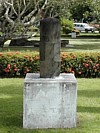
lingam
See
linga.

lingaparvata (लिङ्गंपर्वत)
Sanskrit. 'Mountain emblem'. A
mountain peak in the form of a
linga.

lion
In Hinduism the lion is the
mount of the goddess Lakshmi, of Devi who is also known as in many other
forms and by numerous other names (i.e. Uma, Parvati, etc.), and of the
god Manjushri. In Buddhism it is the protector of the dhamma, and in
that way often seen as symbolic guardians at temple entrances in North
Thailand and Burma, usually in pairs. Together with the bull, the
elephant and the horse, it is also one of the four animals, that
represent the four stages in the life of the Buddha.

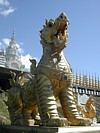
lishi
(利事)
Chinese. 'Beneficial thing' or
'profitable item'. Another name for the money that is put in red
envelopes, called
hong bao.

Li Shi Xian Guan (利市仙官)
Chinese. 'Immortal official of
market profits' or 'lucky money immortal official'. It is the name of an
informal god of wealth, more accurately the 'official of the god of
benefit' and the deity that accompanies other Chinese wealth gods. He is
also one of the Wu Lu Cai Shen or 'five path wealth gods', namely the
god of the northern direction. Li Shi means 'profit from transactions'
and Xian Guan means 'immortal official'. He is a deity that takes on a
specific role in the promotion of trade and the accumulation of
commercial wealth. Amongst the Chinese it is the custom to stick his
image on the inside of the entrance door of shops and business premises
as the deity who calls in mercantile profits. His full name is Li Shi
Xian Guan Yao Shao Si.

Li Shi Xian Guan Yao
Shao Si (利市仙官姚少司)
Full Chinese name of
Li Shi Xian Guan.

Li Tieh-kuai (李铁拐)
Chinese. Name of one of the
Eight Immortals, who is generally depicted as an old man holding a
crutch and a calabash. The name Tieh-kuai is a compound of tieh meaning
'strong', 'solid' or 'iron', and kuai, short for kuai zhang which means
'crutches'. In literature, Tieh-kuai is hence referred to as 'Iron
Crutch'. In his calabash he carries a magical medicine that can cure any
illness and never empties which he dispense to the sick. According to
legend, he initially was a handsome man, but one day his spirit
travelled to heaven to visit some immortals and on his return he found
that his body had been cremated. He thus had to take another body and
the only one available was that of an old and poor beggar with a lame
leg, who had just died of starvation. Having been a student of Lao Tzu
before, the founder of Taoism gave him a strong crutch that would never
break and ordered Li Tieh-kuai to travel to many lands to cure the sick
and to alleviate their pain. Due to his association with medicine, an
iron crutch, his symbol, can now still be found hanging outside some
traditional Chinese apothecaries. Although benevolent to the sick and
the needy, he is also known to be grumpy and bad-tempered. Also
transcribed Li Tie Guai.


Liu
Hai (刘海)
Chinese. Name of a male deity
who is an informal Chinese wealth god in Taoism. His forehead is covered
with short hairs and he rides a toad, his personal pet, called chanchu.
It conveys him to any place he wishes to go, but occasionally it would
escape down a well, and Liu Hai would then lure it out with a line
baited with gold coins. Often depicted with a beckoning hand and with
stringed coins. Also known as Liu Hai Chan and Hai Chan Zi. 

loka (लोक)
Sanskrit. 'World, region, or sphere (of a deity)'. A classification of
the universe. In general the triloka or 'three worlds' are heaven or
paradise, earth and hell. Other categorizations mention seven and twenty
two worlds, united in the 'Egg of Brahma' and referring to the several
sections within each main division.

lokapala (लोकपाल)
Sanskrit. 'Guardian of the world'. In Hindu mythology there are eight
lokapalas presiding over the four points of the compass and the four
intervening directions. Indra protects the East, Yama the South, Kubera
or Vaisravana the North and Varuna the West. The intervening directions
are guarded by Ishana (Shiva) or Prithivi in the Northeast, Agni
protects the Southeast, Surya or Nairriti the Southwest, and Vayu the
Northwest. In Buddhism there may be four, eight, ten or fourteen
lokapalas.


Lokesvara (लोकईश्वर)
Sanskrit. 'Lord of the world'. A form of the bodhisattva Avalokitesvara,
who was at the centre of a prevalent cult in ancient Cambodia. He is
represented on the towers of the Bayon temple and appears frequently in
Khmer bas-reliefs. During the reign of Jayavarman VII Buddhism in the
Khmer empire consisted principally of the worship of a triad made up of
the Buddha, Lokesvara and Prajnaparamita together with the tantric deity
Hevajra. They are symbolically represented by three majestic monuments,
namely Preah Khan commemorating Lokesvara, Bayon in honor of the Buddha,
and Ta Prohm dedicated to Prajnaparamita.

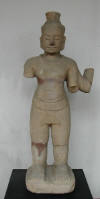
long (龙)
Chinese for
dragon.

lotus
A flower of the family of water lilies, and sacred
among the Hindus. The flower is associated with the divine birth of the
Buddha and used symbolically in Hindu and Buddhist art, often
represented in gold or gilded. The lotus is praised in the sacred mantra
Aum mani padma hum. According to legend Brahma comes from the golden
lotus that emerges from the navel of Vishnu, and the Buddha took seven
steps immediately after his birth causing lotus flowers to bloom
wherever he touched the earth. They are a metaphor for Enlightenment
because they rise from the mud towards light, like Buddhism raises
itself above depravity, and the petals symbolize the Four Noble Truths
and the Eightfold Path that the Buddha revealed to the world. When
opened they unveil the hard core with its seeds, an allegory for new
life. The pedestal used as a base for some Buddha images (tahnphraphuttarup)
are in the form of a lotus and in the wai, the Thai greeting, the hands
are brought together in the flame-like shape of a closed lotus flower to
pay respect. Some parts of the flower are fit for human consumption,
such as its root and its seeds. From the root a sweet and aromatic,
brown coloured health drink called nahm rahk bua is made which is said
to be refreshing and a cure against oral blisters caused by dehydration.
The seeds are acorn-shaped and sit in a large cup-like seed head. This
calyx is called fak bua (ฝักบัว) in Thai which is the same word as for a
shower head, which shape it resembles. However, before consumption the
green skin of the seeds should be peeled off and the tiny yellow-green
shoot that sits in the centre of the seed should be removed as it tastes
quite bitter. Lotus seeds and seed heads can be found on markets
nationwide and peeled creamy white lotus seeds with their distinctive
brownish top can be found in bulk above all in Bangkok's Chinatown. The
giant leaves of the lotus are completely water-repellent and its surface
structure has been imitated in certain technical applications. Lotus
plants are often used as ornamental plants in ponds or pots, especially
in temple gardens or at temple buildings.


Lucky Money Toad
See
kaangkok sawan.

Lumbini (लुम्बिनी)
Sanskrit. The park near Kapilavatthu in
present-day Nepal, where prince Siddhartha, the historical Buddha was
born.

luohan (罗汉)
1. Chinese term for Buddhist arahats, comparable
to Immortals, who are called xian. Sometimes called lohan.

2. Chinese name for the flowerhorn, a kind of fish
with a distinctive hump on the forehead of male adults, which resembles
that of Shou, the Chinese god of longevity, who in Thai is known as Siw,
and who is a member of the Three Star Gods, Hok Lok Siw. The fish
belongs to the family of cichlidae.


luopan (罗盘)
Compass used to ascertain the auspicious
orientation of buildings by someone involved with geomancy. See also
feng shui.

_small.jpg)
Lu Tong-pin (呂洞賓)
Chinese. Name of one of the Eight Immortals, said
to be the most unrestrained of them all. Although Chung-li Chuan is
regarded as the official leader of the group, many consider Lu Tong-pin
the informal, de facto leader. He is believed to be born around the
8-10th century AD (some sources claim 796 AD) and was of princely
descent. While still a student he met a fire dragon who gave him a magic
sword with which he could conceal himself in heaven. One day, he visited
a tavern and met with Chung-li Chuan. While Chung-li Chuan warmed up a
pot of wine (some sources speak of a pot of millet), Lu fell asleep and
saw the whole future of his life in a dream. He dreamt that he would
enjoy good fortune for a long time but then would run out. He dreamt
that he took the imperial exam, excelled and thus was awarded a
prestigious office. He married the daughter of a prosperous household
who bore him a son and a daughter and was promoted to be the prime
minister. But, his success and good fortune attracted jealousy of others
and he was slandered and falsely accused of corruption which caused him
to lose his office. His wife then betrayed him, his children were killed
by bandits, and he lost all his wealth. As he was dying on the street in
the dream, he woke up. The characters from his dream were actually
played by Chung-li Chuan, in order to make him realize that one should
not put too much importance on transient glory and success. As a result,
Lu Tong-pin became convinced of the worthlessness of earthly ambition
and decided to renounce the world. He followed Chung-li Chuan into the
Ho Ling Mountains in order to seek the Tao and achieve immortality,
eventually becoming a Xian. In art he is usually depicted dressed as a
scholar whilst holding a jamajurih and bearing a sword on his back. His
benevolence is represented in the Chinese proverb 'the dog bites Lu
Tong-pin' which means to repay kindness with unfriendliness due to an
inability to recognize goodness. Also transcribed Lu Dongbin, Long
Dongbin and Lu Tung Pin, sometimes called Lu Yan and nicknamed Shun Yang
Tzu.

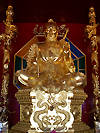 |